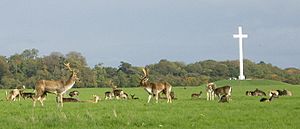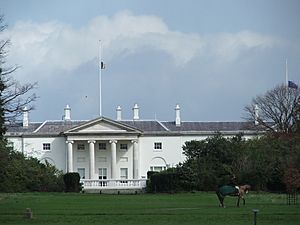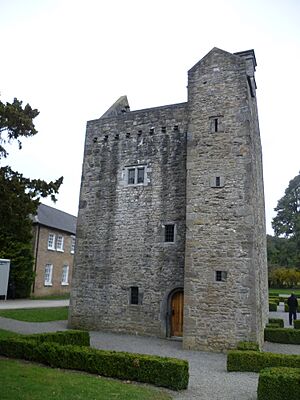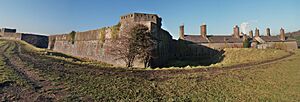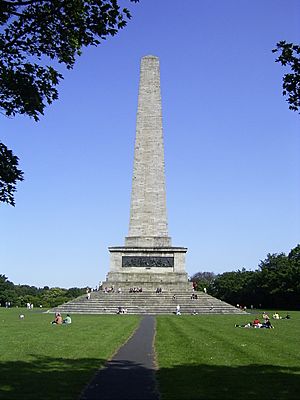Phoenix Park facts for kids
The Phoenix Park (which is Páirc an Fhionnuisce in Irish) is a huge park in the middle of Dublin, Ireland. It's about 3 kilometers (1.9 miles) west of the city center, located north of the River Liffey. The wall around the park is 16 kilometers (9.9 miles) long! The park covers a massive area of 707 hectares (1,747 acres), making it one of the largest walled city parks in Europe. It has big grassy areas and wide roads lined with trees. A group of wild fallow deer have lived in the park since the 1600s. The English name "Phoenix" comes from the Irish words fionn uisce, which mean "clear water."
Contents
History of the Park
A special hunting park was created here in 1662 by Lord Ormonde, who was the English Lord Lieutenant of Ireland at the time. A Lord Lieutenant was like a governor, representing the King or Queen of England in Ireland. This park was home to pheasants and wild deer. A wall was built around the whole area to keep the animals from escaping.
The park used to be even bigger, stretching south of the River Liffey. But in 1680, when they started building the Royal Hospital Kilmainham in Kilmainham, the park was made smaller to its current size. In 1745, Lord Chesterfield opened the park for everyone in Dublin to enjoy.
Things to See in the Park
Áras an Uachtaráin
Áras an Uachtaráin is an Irish phrase that means "the house of the President." This is where the President of Ireland lives! It was built in 1754. It was first known as the Viceregal Lodge because it was the home of the English Lord Lieutenant of Ireland.
Chief Secretary's Lodge
The Chief Secretary's Lodge was once the home of the Chief Secretary for Ireland, another important official. Since 1927, it has been the official home of the United States Ambassador to Ireland.
Phoenix Park Visitor Centre and Ashtown Castle
The oldest building in the park is Ashtown Castle. It's a medieval tower house from the 1400s. It was fixed up in 1989. You can find it next to the Visitor Centre, which has lots of information about the park's 5,500-year history.
Magazine Fort
The Magazine Fort is in the south-east part of the park. A building called Phoenix Lodge was first built here in 1611. In 1734, that house was taken down because Lord Dorset, who was Lord Lieutenant of Ireland, wanted a powder magazine for Dublin. A powder magazine is a building used to store gunpowder safely. An extra part was added to the fort in 1801 for soldiers. A famous event called the Christmas Raid happened here in 1939.
Dublin Zoo
Dublin Zoo is home to over 600 animals and tropical birds from all over the world. It was started in 1830 and opened to visitors on September 1, 1831. This makes it the third oldest zoo in the world! It received animals from the Zoological Society of London. Within just one year, the zoo had 123 different kinds of animals.
Monuments in the Park
The Wellington Monument is a very tall stone pillar, called an obelisk, standing 62 meters (203 feet) high. It was built to remember the victories of Arthur Wellesley, 1st Duke of Wellington. It is the largest obelisk in Europe. It would have been even taller, but the money for building it ran out!
The phoenix monument is a tall column with a Phoenix bird at the very top, looking like it's rising from ashes. Lord Chesterfield had it built in 1747.
The Papal Cross is a huge cross placed in the park for the visit of Pope John Paul II on September 29, 1979. More than one million people came to an outdoor mass in the park that day. The large white cross is 35 meters (115 feet) high and is made of steel.
Nature and Gardens
There are 351 different kinds of plants in the Phoenix Park. Three of these plants are rare and protected, meaning they are very special and need to be looked after. The park has kept most of its old grasslands and woodlands. It also has some rare examples of wetlands, which are areas of land covered with water. The 400 to 450 fallow deer living there today are descendants of the original herd.
A survey in 2007-2008 found 72 different types of birds in the park. These included birds like the buzzard, sparrowhawk, kestrel, and jay.
The park also has several small streams that flow into the nearby River Liffey.
People's Gardens
These beautiful gardens were created in 1840. They were first called the "Promenade Grounds," which means grounds for taking a walk. They have small lakes, a playground for children, and a picnic area. You can find these gardens close to the Parkgate Street entrance.
Furry Glen
The south-western part of the park is known as the Furry Glen. It has several short walking paths around a small lake. Here you can see many birds, plants, and other wildlife.
Events in the Park
The park has many sports fields for football, hurling, soccer, cricket, and polo.
Phoenix Cricket Club
Phoenix Cricket Club is located in the park. It was started in 1830 by John Parnell, who was the father of Charles Stewart Parnell. It is the oldest cricket club in Ireland. In the 1930s, 1940s, and 1970s, it was the most important cricket club in the Leinster area.
Motor Racing Events
Motor racing first happened in the Phoenix Park in 1903. The Irish Gordon Bennett Race Speed Trials were held on the main straight road for both cars and motorcycles. After that, in 1929, the first of three Irish motor racing Grand Prix events took place.
Racing continued from 1932 until World War II started in 1939. It began again after the war in 1949 with a sprint race on the Oldtown circuit. Over the years, seven different race tracks have been used in the park. Two of them are even named after the famous Ferrari World Champion racing driver Mike Hawthorn.
Great Ireland Run
The Great Ireland Run is a 10-kilometer (6.2-mile) running competition. It has been held every year in April since 2003. It includes races for professional runners and for the public. In 2010, over 11,000 people took part in the run.
Bloom
A large event about gardening, food, and family fun called "Bloom" is held in the park every year since 2006. It had almost 90,000 visitors in 2011!
Concerts
Many famous music acts have played concerts in the park. These include bands like U2, Coldplay, Duran Duran, Robbie Williams, Red Hot Chili Peppers, and Kanye West.
Phoenix Park in Popular Culture
The park plays a big part in James Joyce's famous novel, Finnegans Wake.
Images for kids
See also
 In Spanish: Parque Fénix para niños
In Spanish: Parque Fénix para niños


